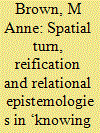| Srl | Item |
| 1 |
ID:
175359


|
|
|
|
|
| Summary/Abstract |
How we approach knowing conflict and security makes a difference. This article first considers how reification, instrumental subject/object relations and the drive for certainty and control undermine effective knowledge and practice in questions of conflict and peace. It then turns to what the spatial turn and notions of emplaced security might offer to working against violence. As with any theoretical perspective, the spatial turn can itself be reified, repeating epistemological relations entrenched in much security analysis. The spatial turn and emplaced security explicitly highlight alternative, more relational knowledge practices, however. A relational epistemology approaches knowledge not only as information about a subject out there, but also as a form of practice with others which changes conditions of possibility for co-existence. If pursued, such approaches could help loosen the grip of narrow constructions of security, insecurity, the person, power and agency which dominate security analysis and obstruct understanding and the generation of alternatives in situations of entrenched conflict. An orientation to place could not only enable more nuanced accounts of peace and conflict, but support mutual recognition and exchange across division, assisting an ethic of attention and concrete peace and conflict resolution efforts.
|
|
|
|
|
|
|
|
|
|
|
|
|
|
|
|
| 2 |
ID:
190857


|
|
|
|
|
| Summary/Abstract |
Peace zones are popularly understood as demilitarized geographic areas. While many peace zones have been documented around the world, scholarly research on the topic is surprisingly sparse. Furthermore, the existing literature focuses toward analyzing the complex social and temporal dynamics of peace zones. There is less work that examines the spatial processes that are mobilized in making the peace zones work. Building upon the analytical innovations of the geographic and spatial approaches to peace that highlight the spatialities of scale, space, and place, this article foregrounds the multiple spatialities of peace zones. Through a case study of the peace zone in the indigenous community of Sagada in the Philippines, this article argues that the peace zone is maintained through territoriality, interdependence, and the refusal of violence that weave together the politics of scale, space, and place.
|
|
|
|
|
|
|
|
|
|
|
|
|
|
|
|